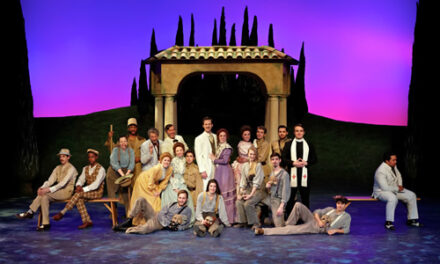Music for a Great Space hit a triple header with fascinating forgotten repertoire, talented musicians with a local connection, and one of the largest and most diverse audiences that the series has had in Christ United Methodist Church. Much of the academic and critical world during the 20th century was dominated by avant-garde music that made mass audiences cringe. This “Between the Wars” program focused on tonal, Romantic composers who continued the tradition stemming from Beethoven through Brahms. Violinist John McLaughlin Williams has made a specialty of exploring forgotten or neglected composers, both as an instrumentalist and as a conductor. His local connection was as an alumnus of Greensboro’s Grimsley High School. A student of Dorothy Delay, Williams once played in the Greensboro Symphony and was concertmaster of the Virginia Symphony. He has an active international career on both sides of the podium. His very able accompanist was Glen Inanga was born in Nigeria, educated in England, and is a Senior Lecturer at the University College of the Cayman Islands while also concertizing internationally. (For a list of his Grammy nominations and award, click here.)
Williams prefaced each selection with brief comments about the composers and their music. He opened with “Horo” from Two Bulgarian Paraphrases for Violin and Piano, Op. 18, by Pancho Vladigerov (1899-1978). Vladigerov, a widely influential Bulgarian composer, wrote in many forms and was highly regarded throughout Europe but is virtually unknown in the US. He adapted Bulgarian folk music to classical forms, and his scores feature uneven meters. Bulgarian horos can have diverse steps and complicated rhythms. This horo was more extensive than expected. It began with an extended exposition with rich lyric lines before leading to a more virtuosic ending.
Austrian Karl Ignaz Weigl (1881-1949) studied with Alexander Zemlinsky, among others; Anton Webern was a classmate of his at the University of Vienna. He was a rehearsal conductor for Mahler at the Vienna Hofoper (1904-06) and taught at the Vienna City Conservatory, where one of his students was Peter Paul Fuchs, who conducted the Greensboro Symphony (1981-92).
Weigl’s Sonata No. 1 in C for Violin and Piano, Op. 16, is an immediately-attractive work, not least for its slow movement, entitled “Song Birds Singing before Night.” The latter featured birdsong-like passages and ended quietly after 12 repeated notes on the piano. The first movement combined soaring melodies with multiple stops. The racing finale alternated between swirling and soaring melodic lines. Williams said he and Inanga will record the Weigl violin sonatas soon.
Pioneering African American composer William Grant Still (1895-1978), who was largely self taught, racked up many firsts. He was the first African-American to conduct a major orchestra, the first to have a symphony performed by a major orchestra, the first to have an opera performed by a major American company, and the first to have an opera broadcast on television. Still drew upon gospel music, ragtime, blues, and jazz to create his style. Many of these influences can be heard in Still’s Suite for Violin and Piano (1943), the three movements of which Williamson said were inspired by sculptures. The opening “African Dancer” is virtuosic, the intimate and deeply moving second movement, “Mother and Child,” can stand alone, and the concluding “Gamin” has a rhythmic, sassy violin part. Some of the keyboard work reminded me of stride piano playing.
English composer York Bowen (1884-1961) was the wild card. In England he is known as the English Rachmaninoff. Williams said this was because Bowen had a real gift for writing great melodies and themes, not the dark, deep brooding gloom of the Russian master. Both Bowen and Rachmaninoff were inspired by Tchaikovsky. While there is an element of the “pastoral music” so characteristic of his colleagues (Vaughan Williams, Elgar, etc.), Bowen was much more vigorous and assertive; he was skilled at creating effects with great economy of means. These virtues are evident throughout Bowen’s Sonata in E Minor, Op.112. The middle slow movement is striking, with extensive muted strings over a filigree keyboard worthy of Debussy. There are fireworks for both instruments in the outer movements with beautiful pizzicatos and multiple stops.
The duo chose to spotlight each player in turn in two brief encores. Inanga gave a fascinating sample of Weigl, the First Fanstasy for Piano (1944). Williams cut loose with the Recitativo and Scherzo, Op. 6, by Fritz Kreisler.
The podium has not dulled Williams’ violinist “chops.” His intonation was excellent and his tone, warm. His agility in the fastest passages, switching from bowing to plucking strings or clarifying fast runs, was impressive. His deep conviction of the musical worth of these unjustly-neglected composers was fully communicated. The Steinway had its lid on the short rest, but Inanga produced a good, rich tone while usually succeeding in balancing with the violin.They played these challenging scores superbly. Earlier in the week, the duo had played for 1,500 local school children and conducted master classes. Both artists ought to be better known and more frequent guests on series throughout the state.
This was the opening concert of 17DAYS, a city-wide festival of art, music, theatre and more.
Note: Concerts presented by Music for a Great Space enrich the Triad’s cultural scene. The next one is October 18. For details of it and the rest of the season, see our calendar.











